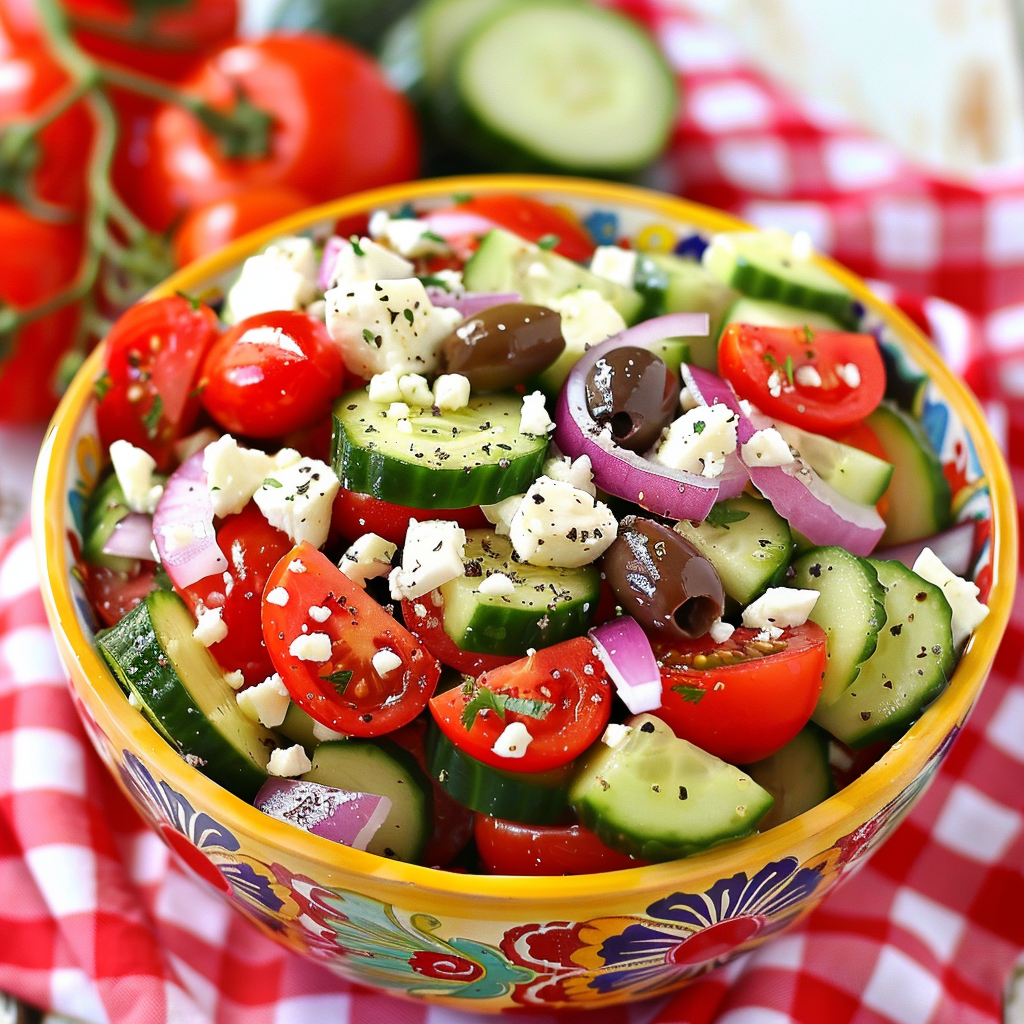Discover the Freshness of Greek Salad with Feta: A Wholesome Mediterranean Meal

Share
Greek Salad is a refreshing and vibrant dish, perfect for a light lunch or as a side to your main meal.
In my kitchen, the vibrant colors of fresh vegetables are always a welcome sight. There’s something deeply satisfying about creating a meal that’s not only delicious but also full of life and color. Greek salad has become a favorite dish when I crave something light yet fulfilling. It’s a meal in itself, especially when paired with a slice of toasted bread. I love heading to the garden to pick the freshest cucumbers and tomatoes in season or visiting the local natural food store to select organic produce. The crispness of a well-chosen cucumber, the juicy sweetness of ripe tomatoes, and the briny bite of Kalamata olives—these are the simple pleasures that make me feel good about the food I’m eating. While my approach to eating might not be for everyone, I’ve found that being mindful of where my food comes from and how it’s prepared has brought a sense of joy and well-being that’s hard to beat.
Did You Know?
Kalamata olives are not just flavorful; they are also rich in nutrients. These olives are an excellent source of healthy monounsaturated fats, which are beneficial for heart health. They also contain antioxidants, which help protect your cells from damage. Kalamata olives are low in cholesterol and provide a good source of dietary fiber, iron, and copper. Their rich, slightly bitter flavor adds depth to dishes like this Greek salad, making them a delicious and nutritious addition to your meals.
Yield: 2 servings
Ingredients:
- 2 cups chopped cucumbers
- 2 cups chopped tomatoes
- 1/2 cup sliced red bell peppers
- 1/2 cup sliced red onion
- 1/2 cup Kalamata olives
- 4 tablespoons crumbled feta cheese
- 2 tablespoons olive oil
- 2 tablespoons red wine vinegar
- 2 teaspoons dried oregano
- Salt and pepper to taste
Instructions:
Assemble Salad:
Combine cucumbers, tomatoes, bell peppers, red onion, and olives in a bowl.
Personal Tip: I always find that mixing the veggies gently ensures they don't bruise, keeping them fresh and crisp.
Make Dressing:
Whisk together olive oil, red wine vinegar, oregano, salt, and pepper.
Personal Tip: Let the dressing sit for a few minutes before using it. The flavors meld beautifully, enhancing the salad.
Dress Salad:
Pour the dressing over the salad and toss gently.
Personal Tip: Tossing the salad lightly keeps the vegetables from getting soggy, maintaining their delightful crunch.
Serve:
Top with crumbled feta cheese and enjoy immediately.
Personal Tip: For an added touch, sprinkle some extra oregano or fresh herbs over the feta just before serving.
Nutritional Information (Per Serving):
Calories, 200 | Protein, 4g | Carbohydrates, 10g | Fiber, 3g | Net Carbohydrates, 7g | Fat, 18g | Saturated Fat, 5g | Cholesterol, 15mg | Sodium, 500mg | Sugars, 5g | Glycemic Index, Low
Kitchen Tips, Great Ideas, How to Save Money:
- Using Fresh vs. Canned Olives: Fresh Kalamata olives offer a richer flavor, but canned olives can be a more convenient and cost-effective option. Just be sure to rinse them well to reduce sodium content.
- Bulk Buying: Purchase olive oil, vinegar, and spices in bulk to save money. These pantry staples have a long shelf life and can be used in a variety of recipes.
- Homemade Dressing: Making your own salad dressing is more cost-effective and healthier than store-bought versions. You can control the ingredients and avoid unnecessary preservatives.
- Seasonal Vegetables: Use vegetables that are in season to get the best flavor and price. Seasonal produce is often fresher and more affordable.
- Cheese Alternatives: If feta cheese is too expensive or not to your taste, try using a less expensive cheese like ricotta salata or even crumbled goat cheese as a substitute.
- Batch Cooking: Prepare larger quantities of the salad ingredients and store them separately in the fridge. This makes it easy to assemble a quick salad for the next few days.
- Reducing Food Waste: Use any leftover salad ingredients in other recipes. For example, chopped vegetables can be added to omelets, wraps, or grain bowls.
- Flavor Enhancements: Add a splash of lemon juice or a sprinkle of fresh herbs like parsley or dill for an extra burst of flavor. Fresh herbs can elevate the taste of your salad significantly.
- Storage Tips: Store the dressing separately if you plan to make the salad ahead of time. This keeps the vegetables fresh and crisp until you're ready to eat.
- Cost-Saving Tips: Look for sales and discounts on fresh produce and other ingredients. Buying in-season and from local farmers' markets can also provide high-quality items at lower prices.
The Differences in Feta Cheese:
Feta cheese is traditionally made from sheep's milk or a mixture of sheep and goat's milk, giving it a distinctive tangy and sharp flavor. However, dairy feta, commonly found in many supermarkets, is often made from cow's milk. This version is typically milder and creamier compared to traditional feta.
Greek feta, known for its robust tanginess and crumbly texture, is the most recognized type. It’s made primarily from sheep's milk, sometimes mixed with goat's milk, and has a sharp, briny flavor. French feta tends to be milder and creamier, making it a good choice for those who prefer a less intense taste. Bulgarian feta is quite salty and firm, offering a strong flavor that pairs well with sweet or fruity dishes.
Dairy feta, made from cow's milk, lacks the distinct tang of traditional feta and has a creamier, less crumbly texture. It’s often less expensive and is commonly used in salads, sandwiches, and other dishes where a milder flavor is preferred. Understanding these differences allows you to choose the right type of feta for your recipes, enhancing the overall taste and texture of your dish.


